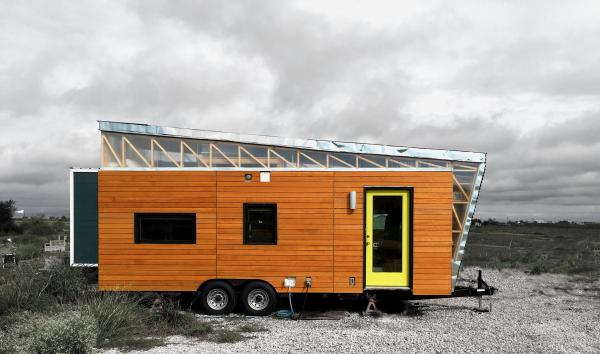UTSOA Graduate Student Davis Richardson on "Tiny House, Big Living"

Master of Architecture student Davis Richardson recently spent nine weeks and $25,000 building a sustainable tiny house. Called “Kinetohaus,” the tiny house will be featured in the January 12 episode of “Tiny House, Big Living” on the DIY Network, which airs at 8:30 pm CT. The episode “Grad School Tiny House” traces Davis's construction of the 240-square-foot house in his parents' driveway. Today, you can find Kinetohaus parked in Del Valle, Texas, within walking distance of Circuit of the Americas.
Davis's work focuses on issues of sustainability and affordable housing. He sees Kinetohaus as a case study for a larger conversation and solution to sustainable living.
Below, Davis describes the project in his own words:
“Kinetohaus” translated simply means “moving house.” In designing and building a tiny house on wheels in which to live while I pursue my M.Arch at UTSOA, I was inspired by the flexibility and dynamism of lifestyle that comes with tiny houses. Unlike conventional buildings on a fixed site, tied to a permanent foundation, this tiny house would be able to go with me wherever life takes me. The form and lines of the house are angular in order to echo, in a small and simple way, the dynamism that this project brings to my life.
Currently located at Austin Live|Work in Del Valle, the house sits on an 8' x 24' flatbed trailer with about 240 square feet. Inside you will find a reading space, a full kitchen with a gas range, refrigerator, and washer/dryer combo unit, a dining and workspace, a living room, bathroom with a full-height shower and composting toilet, and a lofted bedroom. The house was completed in 9 weeks for $25,000 with no professional construction labor. This was vital to the core value of the house – affordable sustainability. With 10% of the building footprint of a typical house, continuous rigid foamboard and spray-insulation, ample daylight, no central heat or A/C and a smart A/C window unit, a tankless water heater, and a composting toilet, the house is a much more flexible, sustainable, and economically feasible alternative to the current culture of American housing.

